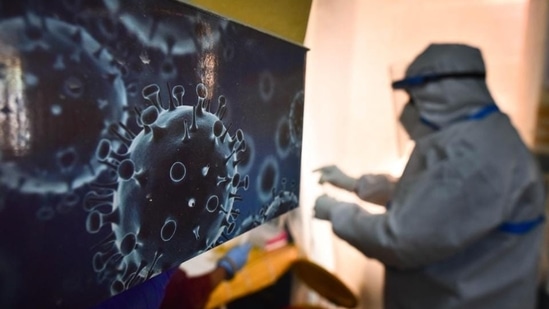Shape of coronavirus affects its transmission: Study
The scientists modelled a specific form of movement known as rotational diffusivity, which controls the pace at which particles rotate as they move through the fluid (in the case of the coronavirus, droplets of saliva).
Images of the coronavirus, SARS-CoV-2, have been imprinted in our brains since the commencement of the COVID-19 pandemic. However, the way we commonly visualise the virus, as a spherical with spikes, is not entirely true. Microscope images of infected tissues show that coronavirus particles are ellipsoidal, with a wide range of squashed and elongated morphologies.

A global study team led by experts from Queen's University in Canada and the Okinawa Institute of Science and Technology (OIST) in Japan has now analysed how different elliptical shapes alter the way viral particles rotate within fluids, influencing how easily the virus can be transferred. The research was just published in the journal Physics of Fluids.
ALSO READ: Long Covid: The good and bad news
"When coronavirus particles are breathed, they move around within the passages in the nose and lungs," explained Professor Eliot Fried, head of OIST's Mechanics and Materials Unit. "We're interested in determining how mobile they are in these environments."
The scientists modelled a specific form of movement known as rotational diffusivity, which controls the pace at which particles rotate as they move through the fluid (in the case of the coronavirus, droplets of saliva). Smoother and more hydrodynamic particles experience less drag resistance from the fluid and rotate more quickly. This rotational speed impacts how successfully coronavirus particles bind to and infect cells.
"If the particles rotate too quickly, they may not spend enough time interacting with the cell to infect it, and if they rotate too slowly, they may not be able to engage in the required way," Prof. Fried explained.
The scientists modelled both prolate and oblate ellipsoids of revolution in their study. These shapes differ from spheres (which have three axes of equal length) in that prolate shapes have one longer axis and oblate shapes have one shorter axis. When taken to their logical conclusion, prolate shapes extend into rod-like shapes, whilst oblate shapes squash into coin-like shapes. The distinctions between coronavirus particles, on the other hand, are more subtle.
By adding spike proteins to the surface of the ellipsoids, the scientists made the model the most realistic yet. Previous studies from Queen's University and OIST demonstrated that the presence of triangular-shaped spike proteins slows the rotation of coronavirus particles, potentially enhancing their capacity to infect cells.
The scientists simplified their model of the spike proteins, with each spike protein represented by a single sphere on the surface of the ellipsoids.
"We then figured out the arrangement of the spikes on the surface of each ellipsoidal form by assuming they all have the same charge," Dr Vikash Chaurasia, a postdoctoral researcher in the OIST Mechanics and Materials Unit, noted. "Identical charge spikes reject each other and prefer to remain as far apart as feasible." As a result, they are equally distributed around the particle, minimising this repulsion."
In their model, the researchers found that the more a particle differs from a spherical shape, the slower it rotates. This could imply that the particles are more capable of aligning and attaching to cells.
The model is still rudimentary, the researchers admit, but it brings us one step closer to understanding the coronavirus's transport features and could help pinpoint one of the components critical to its infective success.
Catch your daily dose of Fashion, Health, Festivals, Travel, Relationship, Recipe and all the other Latest Lifestyle News on Hindustan Times Website and APPs.



